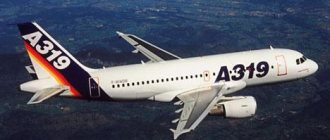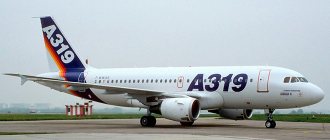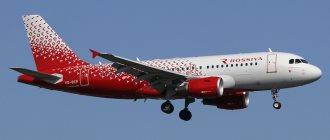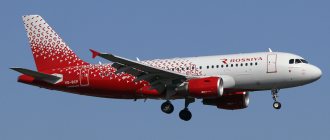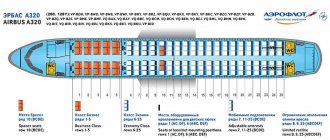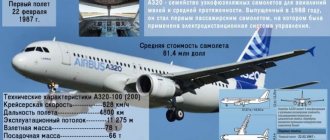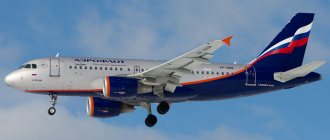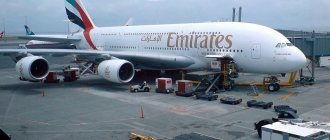The Airbus A350 is one of the latest developments of the French aviation giant, which was designed to become a worthy response to the eternal competitor from the United States - the Boeing Corporation, namely their flagship - the Boeing 787 Dreamliner.
The Europeans managed to develop a completely modern, reliable, functional aircraft, convenient for passengers and pilots, almost from scratch. The car turned out to be outstanding in terms of efficiency, noise levels, and the overall amount of computer technology used. The success of the developers is confirmed by the fact that demand for the A350 model was high even before testing and continues to constantly grow as it operates.
History of the Airbus A350
The manufacturer admits that the history of the aircraft began with a mistake. In 2000, most airlines used the A330, leaving Boeing's jets behind. When a competitor announced the development of the Dreamliner project, Airbus management did not believe that the stated characteristics were achievable. It announced that Boeing's products were a reaction to their success and did not take action.
But in 2004, airline owners were paying more attention to Boeing's proposal. This became noticeable during procurement negotiations: Airbus products were losing ground, because competing airliners consumed 20% less fuel. The problem could not be solved by modernizing old models, and the designers began creating the Airbus 350-900. The process was delayed due to the fact that the project was criticized by potential buyers, and the concern, which was already launching A380 aircraft, did not have enough funds for parallel development.
The first flights of the Airbus A350 took place in 2013, and by this time the manufacturer's expenses had increased from the planned $5.3 billion to $15 billion. A year later, the company received certificates confirming that even if 1 engine fails, the plane will stay in the air for at least 6 hours.
Brief overview and characteristics of the aircraft
Aerodynamically, the Airbus A350 is a low-wing aircraft with a single fin. The wing is swept (sweep 31.9 degrees). Due to the fact that the fuselage of the aircraft is 52 percent made of composite materials, its weight is definitely lower than that of airliners of the same class. Composite materials also provide additional structural strength to the A350, making it a more reliable and safe aircraft. In turn, the lighter weight of the aircraft makes its operation significantly more economical.
Due to the fact that the aircraft’s wing also mainly consists of composites, and also due to its special sweep, the aircraft is capable of developing a good maximum speed, and without any harm to the entire structure. Thus, Airbus carried out a large number of tests and experiments, totaling about 4000 hours, which proved that this particular wing and body configuration is optimal.
The power plant of the airliner is represented by two Trent engines, the power of which depends on the aircraft model. Additionally, Airbus announced the development of Airbus A350 models specifically designed for airlines in the Middle East. In accordance with the local climate (hot and arid), the engines of these models, called “Hot and High” (“hot and high altitude”), will be able to provide greater thrust in conditions of lack of air and extreme heat. Considering the great interest in the aircraft from Emirates Airlines and Qatar Airways, such a project has a great future.
The A350 is also equipped with a Hamilton Sundstrand emergency aircraft turbine, which in critical situations can provide electricity to the aircraft's on-board electronics systems.
Technical characteristics of the Airbus A350 aircraft:
| A350-800 | A350-900 | A350-1000 | |
| Length, m | 60,6 | 66,9 | 73,9 |
| Wingspan, m | 64 | 64 | 64 |
| Height, m | 16,9 | 16,9 | 16,9 |
| Wing area, sq.m | 443 | 443 | 443 |
| Weight | |||
| Max. take-off weight, kg | 245 000 | 265 000 | 295 000 |
| Max. landing weight, kg | 182 500 | 202 500 | 225 500 |
| Fuel tank capacity, l | 150 000 | 150 000 | 150 000 |
| Flight data | |||
| Flight range with max. loading, km | 15 400 | 15 000 | 14 800 |
| Max. cruising speed, km/h | 905 | 905 | 905 |
| Maximum speed, km/h | 945 | 945 | 945 |
| Ceiling (max. flight altitude), m | 13 100 | 13 100 | 13 100 |
| Engines | Trent XWB, | Trent XWB, | Trent XWB, |
| 2 x 34050 kgf | 2 x 39450 kgf | 2 x 43130 kgf | |
| Passenger cabin | |||
| Number of seats (1st class) | 375 | 420 | 475 |
| Number of seats (2 classes) | 312 | 366 | 412 |
| Number of seats (3 classes) | 270 | 314 | 350 |
| Cabin width, m | 5,6 | 5,6 | 5,6 |
The main differences of the Airbus A350 XWB aircraft
The main advantages of the Airbus A350 XWB are as follows:
- To lighten the weight of the aircraft and reduce fuel consumption, the manufacturer used composite materials. 53% of the hull is made from them, 3% more than the Dreamliner: this reduces operating costs.
- The wings, also made of composite materials, have an area of 442 sq.m.: similar characteristics have not yet been achieved in the construction of single-deck models. An innovation was the so-called sharklets - winglets that replaced the classic winglets.
- Special attention was paid to the shape of the airliner, which made it possible to reduce friction during flight. The manufacturer claims to have combined tips from nature with advances in science. As a result of the improved performance, the cabin was expanded, so in a compact configuration the seats are arranged in a 3-4-3 pattern.
- To improve reliability, the chassis design has been revised: a measure necessary due to the use of composite materials. It is equipped with fastenings that evenly distribute the load. The number of wheels on the trolley depends on the aircraft model: for the A350-900 - 4, for the A350-1000 - 6.
- Innovations in the Airbus A350 also affected the cabin. The developer uses 35 cm liquid crystal displays. He also introduced a new 6-screen configuration, which allows pilots to simultaneously see data from various instruments. The cockpit has 2 central displays, 2 navigation and 2 general information (1 each for the pilot and assistant). Indicators have also been introduced that reflect indicators on the windshield: Boeing was the first to use such an innovation.
- Avionics changes were a logical continuation of the developments used on the A380. The number of functions has reached 40 (compared to 23 on the previous model). The manufacturer claims that the result was a reduction in the weight of the aircraft and a reduction in maintenance costs. After all, the new avionics replaced numerous processors by almost 50%!
Improving the performance of the Airbus 350-900 was aimed at reducing maintenance costs. This made it possible to make ticket prices affordable for passengers. Reliability has also been added to the advantages, because the aircraft is capable of staying in the air for up to 19 hours without requiring additional maintenance.
TRAVEL AIR TICKET
Airbus A350 of Aeroflot airline. Photo: Alexander Genscher | TRAVELAVIABILET.RU Today I will fly on the first Russian Airbus A350-900 aircraft of Aeroflot airline. I will share my impressions of the airliner, show photos and videos from the A350 cabin, and also show you spring St. Petersburg from above and the winter Moscow region. Go!
Here he is handsome. Arrived in St. Petersburg. Just yesterday, when I flew here from Moscow, Aeroflot’s schedule included an A350-900, but in fact I was sitting in an A320. Reliable sources at Aeroflot said that the A350 broke down and has been sitting idle for the second week. Yes, I myself, when I was driving to Sheremetyevo, saw him in the far parking lot near Runway-3.
The next morning, when I was already in St. Petersburg, I saw on the Flight Radar that the A350 had been fired up and was already following me to the cultural capital. I was pleased with everything except the cost of tickets for this plane, which turned out to be 4 times more expensive. And what a bummer it was for me and those who never got on it in the previous days and flew with a significant overpayment on an A320 or B737? This is Aeroflot, friends. Good old. Who didn’t even bother to change the type of vessel in the electronic registration.
Aeroflot received the first Airbus A350-900 on March 4, 2022 and immediately began test flights on it on the route Moscow - St. Petersburg - Moscow, mainly to familiarize the crews with the new equipment, and to please as many domestic passengers as possible. This is a long-haul airliner, so of course, it is unlikely that it will fly to St. Petersburg in the future, since it is intended for long-haul flights.
The flights began and immediately ended due to problems with the engine (you can read more about this here). However, Aeroflot resolved this problem within two weeks and today we can look at the future of domestic aviation.
The A350-900 model should eventually replace the good old A330 in Aeroflot's fleet. In total, the airline must receive at least 14 Airbus A350 aircraft. Meanwhile, a business class flight attendant came out to take a look at sunny St. Petersburg.
Aeroflot's Airbus A350 is capable of carrying 316 passengers and transporting them over a distance of up to 16,100 km. The cabin has a three-class layout: 28 in business class (7 rows of 4 horizontally folding seats with direct access to the aisle for each passenger), 24 in premium economy class (3 rows of 8 seats in a 2-4-2 layout and 264 seats in regular economy class (3-3-3 layout).
The first thing you notice is the large luggage racks and intelligent lighting, which changes color and brightness depending on the time of day or phase of the flight, or as the flight attendant asks. Many Aeroflot Boeing 737-800 are already equipped with similar lighting.
The distance between the seats in economy class is decent, you can fall apart.
For example: I put my backpack under the seat in front and it didn’t bother me at all, which would not have worked in a similar arrangement on the A330.
One more nuance, Aeroflot has finally abandoned leather seats that make your ass sick. Especially when you fly for 9 hours. The seats in the A350 economy seemed to me more rigid, but this can be forgiven due to the lack of the above-mentioned materials.
The A350's toilet is brighter, but not more spacious. A completely ordinary cramped toilet, except that they added illumination on the mirror and fashionable LED lighting.
I think that the toilet lacks an interactive screen, like those installed in the backs of seats in the cabin. Since phones in flight do not connect to the Internet, while sitting in the toilet you could enjoy luxurious multimedia entertainment (which will be discussed later). Well, secondly, why can’t the toilet be made a little wider?
While we are taxiing to the runway, you can look not only out the window, but also switch between two cameras. I didn’t limit myself and turned on both on two screens.
From the porthole, St. Petersburg spring bursts with all its colors. And the old Yak-40 of Vologda Airlines takes off.
Let's take off. The Airbus A350 is an indecently quiet aircraft. After lifting off from the runway, a magnificent view of St. Petersburg opens up.
In my case it looks like this.
The multimedia system in the economy class of the Airbus A350 is excellent. This is perhaps the first time that such a wide range of entertainment is offered on board a domestic airline. Passengers are enjoying themselves.
Before the flight, the flight attendants gave the passengers headphones so that they could watch movies during the flight, listen to music or audio books in a huge multimedia library with a normal interface (those who have flown on Aeroflot's A330 will understand me).
I was especially pleased with the interactive maps that show where the plane flies and where you can read about each city you fly over (and not only).
It’s not for nothing that I mentioned the old multimedia system in the A330. Because she was just a bastard. Some of the screens on the plane always didn’t work (I had a case when I was flying on an Aeroflot Airbus A330, where the screen didn’t work in my seat and I really didn’t know what to do with myself for 9 hours), and the navigation and set of functions were so primitive and so slow that I wanted to punch this screen. Thank God Aeroflot solved this problem in the A350.
By the way, the screens are equipped with USB and type C so you can charge your gadgets or work on your laptop. I don’t know what we did to deserve such mercy.
Behind me, a dude in a mask and a Motorhead cap blasted Tsoi at full blast through the headphones from the multimedia system. And he sang along at the chorus “Blood type on the sleeve...”.
Aeroflot flight attendants are the nicest people.
I was invited to generously drink coffee and have a snack that God sent. Why not?
While drinking coffee, I turned on the artificial horizon with instruments on the screen.
While we are hovering over the winter suburbs of Moscow, it’s time to talk about the Airbus A350 family of aircraft.
The Airbus A350-900 began flying in 2014 and became the base version of the A350 family, designed to replace the previous generation of long-haul airliners A330 and A340.
Airbus says the A350-900 is 30% more fuel efficient per seat and has 25% lower operating costs than its Boeing 777-200ER rival.
The author himself
The Airbus A350 has one of the widest cabins among long-haul airliners, its width is 5.96 m. Thus, the aircraft can accommodate up to 9 passenger seats in one row.
Thanks to the latest technologies, the noise level in the A350 cabin is extremely low. Due to the use of composite materials, the fuselage of the airliner allows for higher pressure and humidity in the cabin, which is important for the comfort of passengers on long-haul flights. And new wide windows allow you to enjoy the flight even more than on previous Airbus models.
In addition to the base model A350-900, the manufacturer offers modifications: A350-900R - an aircraft with an increased flight range of 1,500 km due to more powerful engines, as well as A350ULR (Ultra Long Range) - an ultra-long-range version of the Airbus A350 with a flight duration of up to 20 hours in due to the installation of additional fuel tanks (the airliner can accommodate only 170 passengers). Today, airlines are offered two modifications:
- Airbus A350-900 – designed to carry from 325 to 380 passengers over a distance of up to 16,100 km.
- Airbus A350-1000 – designed to carry from 366 to 440 passengers over a distance of up to 14,800 km.
You can read more about the Airbus A350 here.
We board at Sheremetyevo.
Before leaving, I understand that the most important thing about this plane is that it is still new. A fresh interior won't let you lie. And it’s always a pleasure to fly a new one.
The first Airbus A350-900 aircraft in Aeroflot's fleet is named after Pyotr Ilyich Tchaikovsky. This name was chosen in honor of a memorable date: May 7, 2022 will mark the 180th anniversary of the birth of the great Russian composer. The tail number is VQ-BFY.
By the way, another feature of the first A350-900 in Russia is the new Aeroflot livery. The image of the Russian tricolor on the fin became larger, and a waving flag also adorned the wingtips. The lower fuselage is now painted silver instead of dark blue, and features the company name larger than other aircraft.
Curious why there is black paint around the windshields? If anyone knows, please write in the comments.
And finally: since these are black and white days in aviation, I hope that this coronavirus debacle will end as quickly as possible and we will finally start flying new, more advanced aircraft, such as the Airbus A350. Look at him, he's so handsome.
Video review of Aeroflot's Airbus A350
Finding cheap flights
Back
Video: Flight on Aeroflot's Airbus A350
Forward
Video: flight on an Airbus A321 Nordwind Airlines from Yekaterinburg to Moscow
Airbus A350 modifications
In addition to the main model Airbus A350, the manufacturer produces and develops the following aircraft:
- A 350-1000 is designed for 350-366 people, who will be located in 3 classes. The model is designed for flights across the Pacific Ocean.
- The A 350-900 is capable of transporting 314 people over a distance of up to 15 thousand km. The differences lie in economical fuel consumption and cheap maintenance. Work is underway on a cargo version of the A350-900F and a 900R (essentially a stretched A380 model).
- An irbus A 350 ULR was purchased by Singapore Airlines. Aircraft for long-haul flights are planned to be put into operation in 2020. The carrier will purchase 7 aircraft that will connect New York and Singapore. It is planned that the ship will be able to spend 20 hours in the air.
- ACJ350 will be released for corporate transportation. Although the capacity will not exceed 30 passengers, they will cover distances of 20 thousand km.
By 2022, 154 aircraft have been produced, and they are operated by 17 airlines. These include Delta Airlines, Cathay Pacific, Lufthansa, Qatar Airways and Finnair.
Aircraft deliveries are due to begin in 2022.
Which airlines operate the A350?
Today, the modern Airbus A350 is used for long-haul passenger transportation by 23 airlines around the world.
The most famous A350 operators:
- China Airlines is the national carrier of Taiwan, using 14 aircraft of this model;
- Lufthansa, the flag carrier of Germany, maintains 10 A350-900 aircraft in its fleet, with another 15 aircraft expected to be delivered over the next 5 years;
- Asiana Airlines - the South Korean airline operates 6 Airbus 350s on its flights and expects the delivery of another 24 custom-made aircraft;
- Thai Airways, the national carrier of Thailand, has 12 Airbus A350s in its fleet.
Airliners of this model are not yet in operation in Russia.
Articles about other Airbus aircraft:
Review of the Airbus A330 aircraft: characteristics, cabin layout, best seats Review and diagram of the Airbus A300 passenger airliner Characteristics and diagram of the Airbus A310 passenger aircraft Description, models and cabin diagram of the Airbus A340 airliner Description and diagram of the Airbus A319 passenger airliner Airbus A320 - review, cabin layout, where is the best place to sit Sukhoi Superjet 100 - characteristics and best seats on the plane New rules for the permissible weight of baggage on the plane and hand luggage Safety rules in emergency situations on board the plane
Airbus A350: photos
Airbus A350 XWB
What does the Airbus A350-900 model look like?
Photo of the Airbus A350 economy class cabin
Cabin in the business compartment of the Airbus A350 XWB
Cockpit
Economy class: how to choose the best seats in the cabin
The compartment includes rows from 16 to 42, and the distance between them is 78 cm; the seats are arranged in a 3-3-3 pattern. When choosing your seats, consider the following:
- The best location is considered to be at 28 K and 28 A, since there is no chair in front.
- Couples love to fly on 27 B, C, H or J. The seats are arranged in a 2-3-2 configuration, so neighbors don't interfere with communication. Also, the seats are located near emergency exits, which provides additional legroom. There are some drawbacks, because the retractable tables are mounted on the armrests. This reduces the width of the seats, and the proximity of the toilets causes concern.
- Seats 27 D, E and G are considered a bad option: their width is reduced due to the pull-out tables fixed in the armrests. Avoid boarding 41 D and G as you will be concerned about the proximity of the restrooms. But the worst options are the remaining seats in the 41st row and the entire 42nd row, because their backs do not recline.
Other seating options on the Airbus A350 XWB are standard. Although you will not receive additional benefits, the carrier assures that the cabin is so comfortable that you will not feel any discomfort even on long flights.
Business class differences: best and worst options
Almost half of the Airbus A350 XWB cabin is dedicated to the “business” compartment; Seats are arranged in a 1-2-1 pattern. The seat can be folded down to create a 198 cm long bed. If you prefer to stay awake, watch movies on the 15.4-inch screen. And to get maximum pleasure, choose the right places:
- Avoid seating in the 11th, 17th and 18th rows as they are near the restroom and buffet.
- The 19th will appeal to those who want extra legroom. But families with children are often located here, since cradles are attached to the partition.
In general, traveler reviews of flying in the business section are positive; complaints arise only from tall people, to whom the reclined seat seems short.
